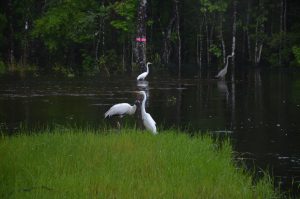
By Les Harrison
The dog days of August are resting heavily upon Wakulla County. It is a daily contest between the thermometer and humidity to see which can generate the highest readings to compound the heat index’s effects.
The resulting elevated stress can be credited to the frequent rain showers and the blazing summer sun which appears between showers. This combination rinses and bleaches everything exposed to these natural elements.
The sugar white sands display the influence of this solarization, as well as many faded shells. The prominence of white on birds in this decolorized environment provides effective camouflage so they can literally blend in to the background for more effective hunting.
One such avian example is the snowy egret. Egretta thula, as this bird is scientifically known, is a full time resident of the beaches and back waters of the gulf coast.
This small heron is in the same family, but not genus, with the cattle egret which is commonly seen in fields and pastures. The cattle egret usually has some rust colored feathers and it arrived in North America about 100 years ago from north Africa and southwestern Europe.
The snowy egret, as the name implies, has white feathers with no supplemental tones or shades. Adults stand about two feet in height, sometime with the appearance of slouching shoulders which rest the head on the chest.
Fashions and styles being what they are, this bird’s fine and fluffy white feathers became quite popular as an adornment for women’s hats during the late 19th century. While mimicry can be flattering, it can also be hazardous to a bird’s survival prospects.
Market hunters, in an effort to capitalize on strong economic demand and high prices for the wispy plumage, focused their efforts on this and similar species. Untold numbers of this bird were slaughtered to satisfy the fickle desires of the style conscious in the urban salons and manor houses.
Luckily for the remaining snowy egrets, feathers became passé for the human population and the hunting pressure was off. Time and Federal protection allowed this species to recover to its former numbers.
This bird eats mostly creatures associated with aquatic habitat. Fish, frogs, and crustacean are on the menu, but so are insects and worms which present themselves to this wading bird.
Its large yellow feet provide a stable platform from which to hunt and are well adapted to raking through the sand and mud to reveal hidden creatures. Their hunting grounds include saltmarsh pools, tidal channels and flats, freshwater marshes, swamps, inlets, and pond edges, usually preferring brackish or marine habitats with shallow water.
Sometimes other foraging water birds will appear to work collectively with the snowy egrets forming a mixed species groups, each using its unique assets to scour for disguised nutrition.
Very few prey species can evade their destiny to these effective predators. Under the bright summer sun in the high humidity, the pressure is intense.
To learn more about the area’s snowy egrets, visit the UF/IFAS Wakulla County website at https://blogs.ifas.ufl.edu/wakullaco or call 850-926-3931.
 0
0
